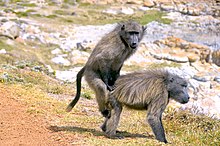Bear Baboon
| Bear Baboon | ||||||||||||
|---|---|---|---|---|---|---|---|---|---|---|---|---|

Bear baboons with young animal |
||||||||||||
| Systematics | ||||||||||||
|
||||||||||||
| Scientific name | ||||||||||||
| Papio ursinus | ||||||||||||
| ( Kerr , 1792) |
The bear baboon or Tschakma ( Papio ursinus ) is a species of primate from the genus of baboons within the family of vervet monkeys (Cercopithecidae). He lives in southern Africa .
features

With a head body length of up to 115 centimeters, plus a tail up to 71 centimeters long, and a weight of 15 to 31 kilograms, they form the largest and heaviest species of baboon. Their fur is dark brown or gray on the top, the underside is lighter, the hands and feet are mostly black. The elongated, hairless snout is dark purple or black in color, as are the seat calluses. The color of the fur and the size are variable according to region, so there is a population with gray paws; particularly small specimens occur in the Kalahari , for example .
The males are significantly larger and heavier than the females and also have longer canine teeth , but unlike the other baboon species, they lack the mane on the shoulders and front back.
distribution and habitat
Bear baboons live in southern Africa, more precisely in Angola , Botswana , Mozambique , Namibia , South Africa and Zambia . They inhabit steppes and savannas as well as open forest areas, but are dependent on the availability of water.
Way of life
Like all baboons they live in groups, mostly in mixed groups, but in some regions (for example in mountainous South Africa) the single-male groups dominate (see group behavior of baboons ). The bear baboons show complex group behavior and communicate by means of postures, facial expressions, sounds and physical contact. Bear baboons are omnivores; they have a penchant for fruits, but also consume leaves, insects, seeds and smaller vertebrates.
Reproduction
The reproduction can take place all year round, the females show a pronounced normal swelling during the fertile phase . In principle, any male can mate with any female within the mixed groups. This leads to sometimes bitter disputes among the males about the mating privilege.
After a gestation period of around 180 days, the female usually gives birth to a single young animal that is initially black in color. The young are weaned at around one year of age, and sexual maturity occurs at three to five years of age. The maximum age of an animal in human care was 45 years, life expectancy is significantly lower in the wild.
Danger
Bear baboons are widespread and are not endangered species. Sometimes they are considered a plague because they devastate plantations.
particularities
In Uitenhage in the second half of the 19th century, a baboon named Jack was the assistant to a handicapped track attendant.
literature
- Thomas Geissmann : Comparative Primatology. Springer-Verlag, Berlin et al. 2003, ISBN 3-540-43645-6 .
- Don E. Wilson, DeeAnn M. Reeder (Eds.): Mammal Species of the World. A taxonomic and geographic Reference. Johns Hopkins University Press, Baltimore MD 2005, ISBN 0-8018-8221-4 .
Web links
- Information at Animal Diversity Web
- Papio ursinus in the endangered Red List species the IUCN 2006 Posted by: T. Butynski & Members of the Primate Specialist Group, 2000. Retrieved on 12 May, 2006.


